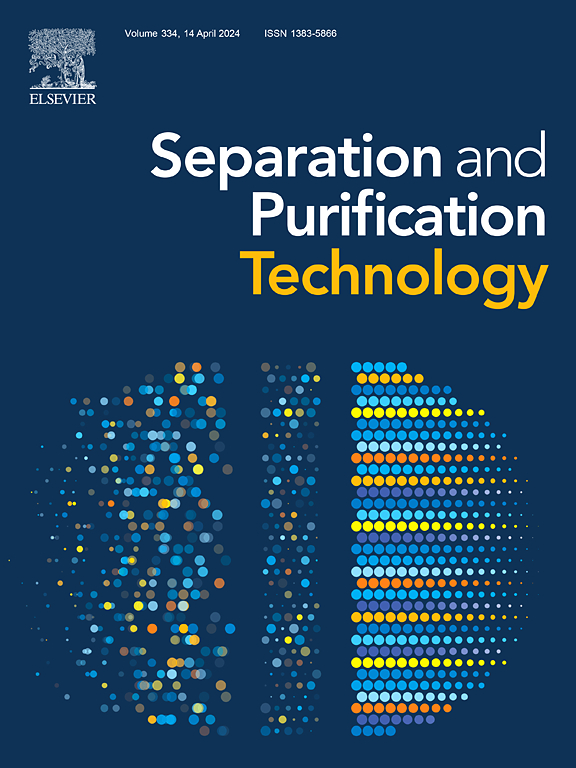从甜茶(Lithocarpus litseifolius (Hance) Chun)中提取氯嗪和三叶皂苷的可切换深共晶溶剂
IF 8.1
1区 工程技术
Q1 ENGINEERING, CHEMICAL
引用次数: 0
摘要
为了提高萃取剂的回收率和重复利用率,最近开发出了可切换深共晶溶剂(SDES)。本研究制备了温度诱导型深共晶溶剂(SDESs),并将其用于甜茶(Lithocarpus litseifolius (Hance) Chun)中黄酮类化合物(具有代表性的叶绿素和三叶皂苷)的萃取。这些 SDESs 溶液可随温度在溶液和沉淀之间切换,并绘制了 SDESs 溶液的相图。通过变温傅立叶变换红外光谱、变温 1H NMR 和变温动态光散射(DLS)等多种表征方法研究了它们的温度响应特性。筛选出 SDES-1(苯甲酰胺:苹果酸=2:1)为最佳萃取剂,通过单因素实验研究了影响萃取过程的主要因素,并采用响应面法(RSM)进行了优化。结果表明,氯嗪和三叶皂苷的萃取率分别为 114.72 和 12.56 mg/g。此外,氯嗪和三叶皂苷的回收率分别达到了 98.46 % 和 94.64 %。因此,这项研究为从植物资源中提取生物活性化合物提供了一种无害环境的策略。本文章由计算机程序翻译,如有差异,请以英文原文为准。

Switchable deep eutectic solvents for the extraction of phlorizin and trilobatin from sweet tea (Lithocarpus litseifolius (Hance) Chun)
Switchable deep eutectic solvents (SDESs) have recently been developed to improve the recovery and reuse of the extractants. In this work, temperature-induced SDESs were prepared and used for the extraction of flavonoids (representative phlorizin and trilobatin) from sweet tea (Lithocarpus litseifolius (Hance) Chun). These SDESs solution can switch between solution and sediment depending on the temperature, and the phase diagram of SDESs solution had been drawn. Their temperature-responsive characteristics were studied by various characterizations, including variable-temperature FT-IR, variable-temperature 1H NMR, and variable-temperature dynamic light scattering (DLS). SDES-1 (Benzamide: Malic acid = 2:1) was screened as the optimal extractant, and the major factors affecting the extraction process were studied by single-factor experiments and optimized by response surface methodology (RSM). The extraction yields for phlorizin and trilobatin were 114.72 and 12.56 mg/g, respectively. Moreover, the recoveries for phlorizin and trilobatin reached 98.46 % and 94.64 %, respectively. This study thus provides an environmentally sound strategy for extracting bioactive compounds from plant resources.
求助全文
通过发布文献求助,成功后即可免费获取论文全文。
去求助
来源期刊

Separation and Purification Technology
工程技术-工程:化工
CiteScore
14.00
自引率
12.80%
发文量
2347
审稿时长
43 days
期刊介绍:
Separation and Purification Technology is a premier journal committed to sharing innovative methods for separation and purification in chemical and environmental engineering, encompassing both homogeneous solutions and heterogeneous mixtures. Our scope includes the separation and/or purification of liquids, vapors, and gases, as well as carbon capture and separation techniques. However, it's important to note that methods solely intended for analytical purposes are not within the scope of the journal. Additionally, disciplines such as soil science, polymer science, and metallurgy fall outside the purview of Separation and Purification Technology. Join us in advancing the field of separation and purification methods for sustainable solutions in chemical and environmental engineering.
 求助内容:
求助内容: 应助结果提醒方式:
应助结果提醒方式:


